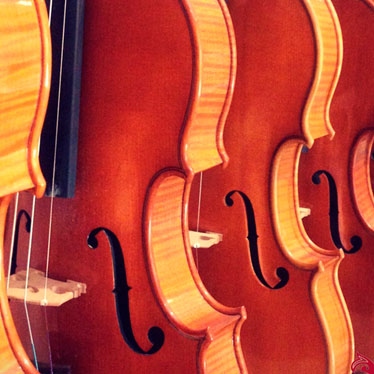Which Features Help Determine The Quality Of A Violin?

For beginners and novice players, it’s not always easy to recognize the features that determine the quality—and essentially the worth—of a violin. On the surface, seemingly identical instruments can astound buyers when the cost difference is made known because the features that indicate quality aren’t always easy to see at first glance.
The workmanship and attention to detail employed to create a violin also influences the quality. While the materials chosen during construction are important, the way that they are shaped and joined equally effects the value and worth of your violin.
There are three main areas that influence the cost and define the quality of a violin: Craftsmanship, Materials, and Sound.
Materials
The materials used to construct a violin affect the quality of the instrument. Special tonewoods are used for each part and are selected for the singular abilities they contribute to the overall perfection of the violin. For example, Spruce wood is used to create the soundboard on the best quality instruments, while maple, ebony, and other hardwoods round out the remaining line up. These woods are chosen for their resonance capacity, and the tonal qualities they possess.
Moreover, the manner in which the wood has been cured makes a difference in the quality of the violin. The curing process helps ensure that uniform proportions are present throughout the instrument so that the sound is enhanced. Although it’s extremely hard to detect by sight, wood that has been dried unevenly will negatively impact the projection and tonal quality of the violin.
A good rule of thumb here is to look for solid wood, not veneered materials. The back is often joined from two or three pieces, but that doesn’t affect the quality.
Craftsmanship
Identifying a quality instrument through its craftsmanship is one of the easiest features to understand and recognize.
Individuals who craft stringed instruments are called Luthiers, and as an artisan profession, there are many different opinions concerning how to perform the techniques involved. Hand-crafted violins are typically more expensive than their manufactured equivalents because of the time and effort involved during fabrication. However in recent years, new manufacturing methods have been developed that combine the best of both worlds. A controlled production environment united with a personal fitting out process produces affordable, quality violins.
Some things to look for include:
- Solid joints—when you press gently on the soundboard, you shouldn’t hear any creaks or squeaks.
- Scrollwork—the scroll detail should have a fairly deep impression.
- Symmetry—when you look at the violin, it should be symmetrical from the top to the bottom, and the end nut and neck should line up accordingly.
- Flush fitting bridge—although any stringed instrument shop can refashion a bridge for the violin (and this is a typical maintenance requirement), when you are looking at a new instrument, an ill-fitting bridge can be a clue into other misaligned parts.
- Gaps around the pegs/pegbox—if the violin has been sitting on the shelf for a while, the seams connecting the top and bottom pieces may become loose—this is not a big issue. Hide glue, which is used to join the seams is designed to allow for future adjustments to the violin and is susceptible to changes in humidity. However, gaps where the box or neck is joined indicate poor quality.
- Perfling—the decorative accent along the edge of the violin is the perfling. It doesn’t have to be an inlaid wood, indeed it’s often not, but the painting or inlay should look neat and evenly applied.
Sound
Although both craftsmanship and materials will, in effect, contribute to the actual sound produced, every violin has its own unique voice. Each instrument has its own range, depth, and tonal abilities. And while there are certain things that you can do to enhance or clarify the tenor of your violin, such as new playing techniques, better strings or a different bow, because each instrument is crafted from living materials, every violin has its own distinctive sound.
The placement of the soundpost (which can shift inside) also affects sound. If you find an instrument that you think is good quality but sounds wretched, it’s worth it to have a luthier check the soundpost.
The characteristics that determine whether or not a violin is a quality instrument are often subtle, but with a bit of practice, you’ll be able to distinguish between an instrument that is worth its price, or one that will present playing difficulties and require constant repairs.

